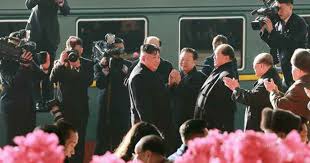Posted on : Feb.25,2019 17:52 KST
 |
|
North Korean leader Kim Jong-un salutes his honor guard ahead of his departure from Pyongyang Station to Hanoi on Feb. 23. (KCNA/Yonhap News)
|
North Korean leader Kim Jong-un departed from Pyongyang on a personal high-security train to Hanoi on the afternoon of Feb. 23. His trip signals the opening of a historic second North Korea-US summit. Compared to the two sides’ first-ever summit eight months ago, the significance of the second summit is by no means small. We look forward to concrete and practical progress being achieved through North Korea and the US’ efforts toward denuclearization of the Korean Peninsula, the establishment of a peace regime, and the normalization of diplomatic relations at their second summit in Hanoi.
The reports of Kim’s departure from Pyongyang that came in over the weekend were significant in several regards. His decision not to travel by aircraft, but to make the journey of 4,500km and over 60 hours to Hanoi by train may be seen as quite unusual. Another difference from the past was the North Korean media’s swiftness in reporting Kim’s departure to the North Korean public early in the morning on Feb. 24. In addition to arousing global interest in Kim’s trip across China, this could also be read as signaling the North’s commitment to and hopes for its second summit with the US.
Hopes for the summit’s outcome have been evident in Washington as well. On Feb. 21, US Secretary of State Mike Pompeo said his last visit to Pyongyang had yielded real progress and voiced his hopes “that the world gets a day [. . .] where no one expects that North Korea will take this [denuclearization] action.” Andrew Kim, who served until recently as head of the CIA’s Korea Mission Center, revealed on Feb. 22 that Kim Jong-un had told Pompeo he did not want his children living with the burden of nuclear arms. This reads as evidence that the Trump administration is favorably assessing Kim’s commitment to denuclearization.
 |
|
North Korean leader Kim Jong-un says goodbye to high-ranking North Korean officials before his departure from Pyongyang Station to Hanoi on Feb. 23. (KCNA/Yonhap News)
|
At the same time, it’s also true that the US Congress and press remain deeply distrustful of Kim Jong-un and intensely skeptical of the second summit. As they meet in Hanoi, the two leaders will bear the responsibility of laying this pessimism to rest and showing the world clearly that the journey to denuclearization has begun.
A few critics are already trying to downplay the results that the second summit produces, arguing that an agreement limited to the dismantling of the Yongbyon nuclear facilities – which North Korea has already indicated its intent to carry out – would amount to the US being “fooled” by Pyongyang once again. But a verbal declaration and actual physical steps are two very different things. If North Korea agrees to the reporting and verification of Yongbyon’s dismantlement and the US responds with a declaration ending the Korean War or the establishment of joint liaison offices, that alone would represent quite substantial and meaningful progress from the first summit.
Obviously it would be much better if the two leaders were to agree on an overall timeline and roadmap for denuclearization. For that to happen, the US needs to show a more flexible stance on economic sanctions against the North. If the inter-Korean economic cooperation card is effectively utilized as South Korean President Moon Jae-in has suggested, nothing is impossible.
The outcome of the second summit will determine whether negotiations on North Korea’s denuclearization will gain greater support and momentum or slide once again into a long deadlock. With Kim Jong-un and Donald Trump now both on the “train to Hanoi,” we look forward to them producing concrete results on denuclearization and improved relations.
Please direct comments or questions to [english@hani.co.kr]










